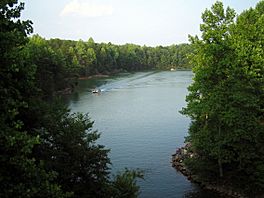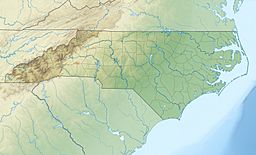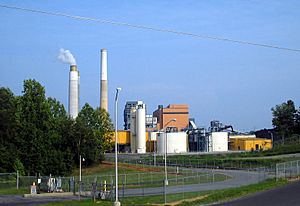Belews Lake facts for kids
Quick facts for kids Belews Lake |
|
|---|---|
 |
|
| Location | Stokes / Rockingham / Guilford / Forsyth counties, North Carolina, United States |
| Coordinates | 36°17′56″N 80°02′15″W / 36.2990°N 80.0375°W |
| Type | reservoir |
| Primary inflows | Belews Creek |
| Primary outflows | Belews Creek |
| Basin countries | United States |
| Max. length | 5.15 miles (8.29 km) |
| Max. width | 0.96 miles (1.54 km) |
| Surface area | 3,864-acre (16 km2) |
| Surface elevation | 722 feet (220 m) |
| Islands | numerous islets |
Belews Lake is a large reservoir (a human-made lake) in North Carolina, USA. It stretches across four counties: Stokes, Rockingham, Guilford, and Forsyth. Duke Energy created the lake in 1973. Its main purpose was to cool down the company's Belews Creek Steam Station, a power plant that used coal to make electricity.
From 1974 to 1986, the power plant released used cooling water into the lake. This water contained harmful substances like selenium. Scientists later studied Belews Lake to understand how these substances affect water environments. Their findings helped us learn a lot about the dangers of high selenium levels in lakes and rivers.
About Belews Lake
Belews Lake covers about 3,864 acres (16 km2) of water. Its shoreline is about 88-mile (142 km) long. A large dam made of earth and a concrete spillway hold the lake's water back.
The northern part of the lake is usually more than 100 feet (30 m) deep. Near the dam, the lake can reach depths of up to 130 feet (40 m). This dam does not produce hydroelectric power.
Belews Lake was formed from Belews Creek. This creek is a small stream that flows into the Dan River. Roads like U.S. Route 158 and North Carolina Highway 65 make it easy to get to the lake. Many people enjoy boating and water skiing here.
There are two marinas on the lake for visitors. Humphrey's Ridge has a grill where you can get food. Carolina Marina offers boat sales and service.
Lake Contamination and Recovery
Belews Lake became contaminated with a substance called selenium. This happened because the nearby Duke Energy power plant released its wastewater into the lake starting in 1974. Selenium can be harmful to animals if they take in too much of it.
Selenium builds up in the food chain. This means that small creatures absorb it, then bigger creatures eat them, and the selenium levels increase. High levels of selenium can cause problems for fish. It can affect their ability to reproduce and cause birth defects. It can also harm their gills, liver, kidneys, heart, and eyes.
Between 1975 and 2002, the number of fish species in Belews Lake dropped sharply. For example, the lake went from 24 species down to just 6. Many fish species, like largemouth bass, had trouble reproducing. Their young could not survive due to selenium poisoning. The lake's fish population changed a lot. It became mostly fish that eat tiny organisms, as they were less affected by the selenium.
Scientists studied the lake in 1988. They looked for many harmful substances. Only selenium was found at levels that caused concern. This led them to believe that selenium was directly causing the fish deaths.
In 1986, the power plant stopped releasing wastewater into the lake. Instead, they started sending the coal waste to a landfill. After this change, sport fish like bluegill and largemouth bass were put back into the lake. They successfully started living there again.
By 1996, selenium levels in the water were much lower. Levels in fish tissues also dropped significantly. However, even ten years later, some fish still had problems reproducing. This is because selenium can build up in the lake's bottom sediments. It can slowly release back into the water and food web over time. If a big storm stirs up the sediments, selenium could quickly re-enter the lake's ecosystem.
Other Concerns: Invasive Fish
In 2011, a new type of fish, the Alabama bass, was illegally put into Belews Lake. This was done for sportfishing. By 2017, the number of Alabama bass grew quickly. At the same time, the native Largemouth bass population in the lake decreased a lot.
There are worries that other native fish, like smallmouth bass, might also disappear. This could happen because the Alabama bass compete with them for food and space. They might also interbreed with them.
To help solve this problem, North Carolina officials removed all catch limits for Alabama bass in Belews Lake. This means people can catch as many as they want, of any size. This effort aims to reduce the number of these invasive fish. Studies at other lakes have shown that Alabama bass can cause big changes in fish populations. They can lead to a long-term decline in native bass species.




